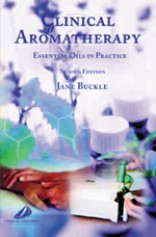|
|
|
| |
 |
|
|

|
 推薦指數:
推薦指數:





|
|
- 內容介紹
|
Clinical Aromatherapy, 2nd Edition
Essential Oils in Practice
Jane Buckle , Complementary Health Therapies Consultant, New York, USAFaculty: University of Minnesota, Minnesota, USA. Adjunct faculty: Bastyr University, Washington, USAAdjunct faculty: College of New Rochelle, New York, USA.
ISBN 0443072361 · Paperback · 236 Pages · 20 Illustrations
Churchill Livingstone · Forthcoming Title
Aromatherapy is one of the main complementary therapies to be practiced by nurses and other health care professionals in hospital, hospice and community settings. Written by a nurse, this clinical text highlights how aromatherapy can enhance care and the role of the healthcare professional. It examines key facts and issues in aromatherapy practice, and applies these within a variety of contexts and conditions, taking a carefully holistic approach in dealing with the patient.
Features
An introduction to the principles and practice of aromatherapy, including contraindications and toxicity.
Contains an in-depth clinical section dealing with the management of common problems such as infection and pain.
Gives examples of which specific oils might be used in treatment.
Illustrates the application of aromatherapy in specific clinical specialties, particularly nursing.
Draws on over 700 references
Includes a new chapter on psychiatric nursing and aromatherapy to include: depression, psychosis, bipolar, compulsive addictive, addiction and withdrawal.
Contents
Part I: Overview .
Introduction. The nature of aromatherapy (History of aromatherapy: an outline. How essential oils work. Routes of absorption of essential oils) Essential oils. (Extraction of essential oils. Functions of essential oils in living plants. Use of essential oils. Chemistry of essential oils. Buying essential oils. Essential oil toxicity. Herbal oils and floral waters.) Contraindications (Possible skin reactions. Chronic toxicity. Reactions with orthodox drugs. Essential oils and homeopathy. Contraindications. Safety and storage. Essential oils as medicines.) Regulations and health and safety policies. (Sample health and safety policy. Sample hospital protocol.)
Part II: Clinical use of aromatherapy .
Aromatherapy in the context of nursing (Conceptual framework. Psychiatric nursing. The nurse practitioner. Nursing diagnosis. Conclusions). General hospital care. (Infection. Pain. Nausea and vomiting. Inflammation. Insomnia. Stress management.) Clinical use in specialized departments. (Cardiology. Care of the elderly. Critical care. Dermatology. Endocrinology. Gynecology. Immunology. Oncology. Pediatrics. Palliative and terminal care. Respiratory care.) Aromatherapy in manual therapies (Massage therapy. Physiotherapy.)
Part III: Useful information .
Training. (Accreditation, validation and certification. Training. Aromatherapy organizations.)
Summary. Appendices. Recommended reading.
|
|
|

